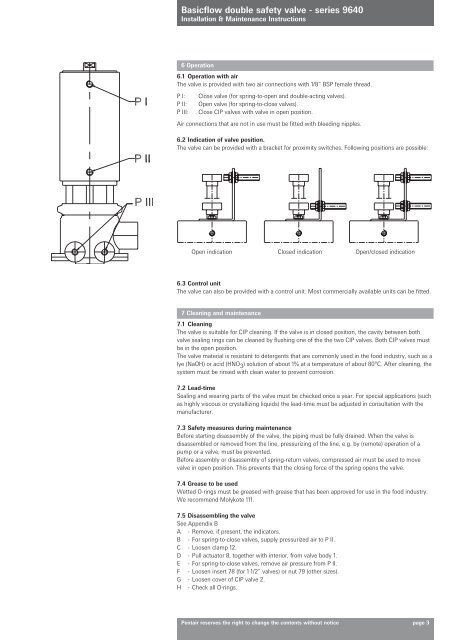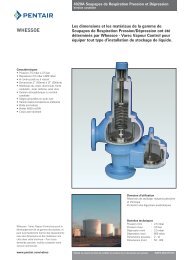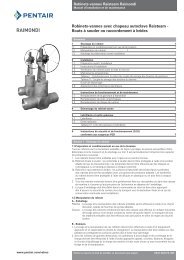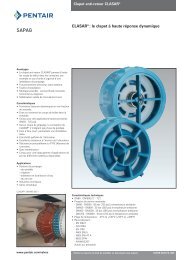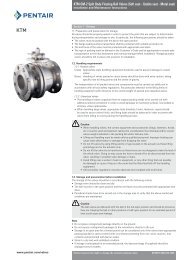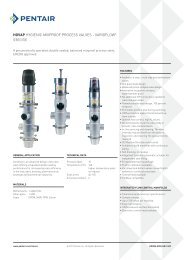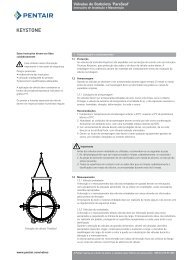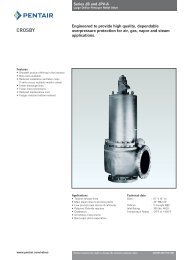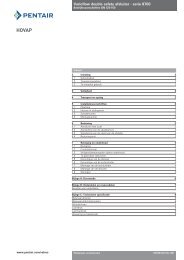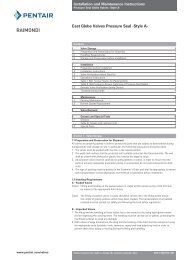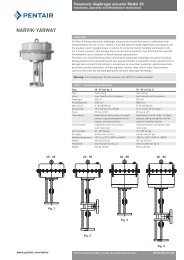Basicflow double safety valve - series 9640 - Pentair Valves & Controls
Basicflow double safety valve - series 9640 - Pentair Valves & Controls
Basicflow double safety valve - series 9640 - Pentair Valves & Controls
Create successful ePaper yourself
Turn your PDF publications into a flip-book with our unique Google optimized e-Paper software.
<strong>Basicflow</strong> <strong>double</strong> <strong>safety</strong> <strong>valve</strong> - <strong>series</strong> <strong>9640</strong>Installation & Maintenance Instructions6 Operation6.1 Operation with airThe <strong>valve</strong> is provided with two air connections with 1/8” BSP female thread.P I: Close <strong>valve</strong> (for spring-to-open and <strong>double</strong>-acting <strong>valve</strong>s).P II: Open <strong>valve</strong> (for spring-to-close <strong>valve</strong>s).P III: Close CIP <strong>valve</strong>s with <strong>valve</strong> in open position.Air connections that are not in use must be fitted with bleeding nipples.6.2 Indication of <strong>valve</strong> position.The <strong>valve</strong> can be provided with a bracket for proximity switches. Following positions are possible:Open indication Closed indication Open/closed indication6.3 Control unitThe <strong>valve</strong> can also be provided with a control unit. Most commercially available units can be fitted.7 Cleaning and maintenance7.1 CleaningThe <strong>valve</strong> is suitable for CIP cleaning. If the <strong>valve</strong> is in closed position, the cavity between both<strong>valve</strong> sealing rings can be cleaned by flushing one of the the two CIP <strong>valve</strong>s. Both CIP <strong>valve</strong>s mustbe in the open position.The <strong>valve</strong> material is resistant to detergents that are commonly used in the food industry, such as alye (NaOH) or acid (HNO 3 ) solution of about 1% at a temperature of about 80°C. After cleaning, thesystem must be rinsed with clean water to prevent corrosion.7.2 Lead-timeSealing and wearing parts of the <strong>valve</strong> must be checked once a year. For special applications (suchas highly viscous or crystallizing liquids) the lead-time must be adjusted in consultation with themanufacturer.7.3 Safety measures during maintenanceBefore starting disassembly of the <strong>valve</strong>, the piping must be fully drained. When the <strong>valve</strong> isdisassembled or removed from the line, pressurizing of the line, e.g. by (remote) operation of apump or a <strong>valve</strong>, must be prevented.Before assembly or disassembly of spring-return <strong>valve</strong>s, compressed air must be used to move<strong>valve</strong> in open position. This prevents that the closing force of the spring opens the <strong>valve</strong>.7.4 Grease to be usedWetted O-rings must be greased with grease that has been approved for use in the food industry.We recommend Molykote 111.7.5 Disassembling the <strong>valve</strong>See Appendix BA - Remove, if present, the indicators.B - For spring-to-close <strong>valve</strong>s, supply pressurized air to P II.C - Loosen clamp 12.D - Pull actuator 8, together with interior, from <strong>valve</strong> body 1.E - For spring-to-close <strong>valve</strong>s, remove air pressure from P II.F - Loosen insert 78 (for 1 1/2” <strong>valve</strong>s) or nut 79 (other sizes).G - Loosen cover of CIP <strong>valve</strong> 2.H - Check all O-rings.<strong>Pentair</strong> reserves the right to change the contents without notice page 3


